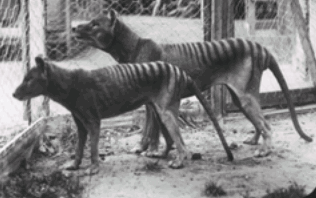|
|
|
|
|
|
|
News & Views item - April 2012 |
![]() Did Extensive Inbreeding of the Tasmanian Tiger Contribute to Its Extinction?
(April 19, 2012)
Did Extensive Inbreeding of the Tasmanian Tiger Contribute to Its Extinction?
(April 19, 2012)
 A
paper in
PLoS ONE 7(4): e35433.
doi:10.1371/journal.pone.0035433 by Brandon R. Menzies et al.
titled "Limited Genetic Diversity Preceded Extinction of the Tasmanian Tiger"
concludes that data derived from a "hyper-variable DNA control region from the
mitochondria of 12 museum-archived specimens collected between 102 and 159 years
ago were on average 99.5% identical.
A
paper in
PLoS ONE 7(4): e35433.
doi:10.1371/journal.pone.0035433 by Brandon R. Menzies et al.
titled "Limited Genetic Diversity Preceded Extinction of the Tasmanian Tiger"
concludes that data derived from a "hyper-variable DNA control region from the
mitochondria of 12 museum-archived specimens collected between 102 and 159 years
ago were on average 99.5% identical.
The authors from Melbourne; Berlin; Storrs, Connecticut and Leibniz conclude: "our data suggest that the thylacine population in Tasmania had limited genetic diversity prior to its extinction, possibly as a result of their geographic isolation from mainland Australia approximately 10,000 years ago.
Below is the paper's full abstract:
The Tasmanian tiger or thylacine was the largest carnivorous marsupial when Europeans first reached Australia. Sadly, the last known thylacine died in captivity in 1936. A recent analysis of the genome of the closely related and extant Tasmanian devil demonstrated limited genetic diversity between individuals. While a similar lack of diversity has been reported for the thylacine, this analysis was based on just two individuals. Here we report the sequencing of an additional 12 museum-archived specimens collected between 102 and 159 years ago. We examined a portion of the mitochondrial DNA hyper-variable control region and determined that all sequences were on average 99.5% identical at the nucleotide level. As a measure of accuracy we also sequenced mitochondrial DNA from a mother and two offspring. As expected, these samples were found to be 100% identical, validating our methods. We also used 454 sequencing to reconstruct 2.1 kilobases of the mitochondrial genome, which shared 99.91% identity with the two complete thylacine mitochondrial genomes published previously. Our thylacine genomic data also contained three highly divergent putative nuclear mitochondrial sequences, which grouped phylogenetically with the published thylacine mitochondrial homologs but contained 100-fold more polymorphisms than the conserved fragments. Together, our data suggest that the thylacine population in Tasmania had limited genetic diversity prior to its extinction, possibly as a result of their geographic isolation from mainland Australia approximately 10,000 years ago.